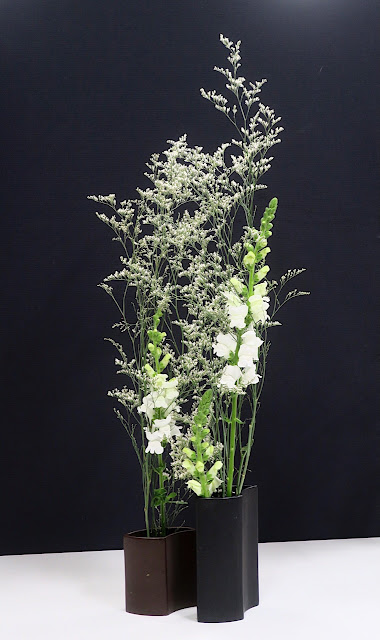When walking along the path at the back of our house a couple of days ago I was really surprised to see this Sulphur-crested Cockatoo chewing the bark on a large Moonah Melaleuca lanceolata. I became even more surprised when it did not fly away even though I passed by at a distance of less than 3 metres.
* * * * *
In a recent class I set my Torquay students the exercise of making an Autumn ikebana. I was pleased that the students were able to find branches with autumn leaves to use. Such northern hemisphere plants do not tend to grow so well by the coast because of salt laden winds and often poor soil.
Marta's principal material was Smokebush Cotinus, Japanese maple Acer palmatum and fine lines from an unidentified branch that had been stripped of its leaves.
Pamela also used Manchurian pear, Japanese maple and some Cotoneaster providing a green contrast and the addition of red berries.
Róża used Passion fruit vine Passiflora edulis and a small stem of Hydrangea for the principal lines in her ikebana. The mass in the arrangement is made with Hydrangea flowers and leaves, which have changed colour in the cool of the autumn nights.
My Geelong senior students were set the task of making an Ikebana on the theme of "Intertwining materials". Although it is not a requirement, this exercise is easier if two different materials are used. An additional requirement of the exercise was to use two vessels.
Jo's exercise was an ikebana in a suiban without using a kenzan. She used Magnolia grandiflora as the principal material with long stemmed roses as a focal point.
My ikebana this week was for an Ikebana International workshop yesterday, which was led by my ikebana colleague Chieko Yazaki, head of Shogetsudo Koryu in Victoria. Cheiko and two of her students demonstrated using baskets and a traditional wooden water bucket as vessels for ikebana.
I made my ikebana in a shallow woven bamboo basket with a complicated design in the weave. The ikebana is a simple, informal autumn arrangement using some pink-tinged Nandina domestica and a white Camellia with pink edges on the petals. At the appraisal I was relieved when Chieko commented that she was happy with the Camellias being partially obscured by the Nandina.
Greetings from Christopher
12th May 2024











No comments:
Post a Comment